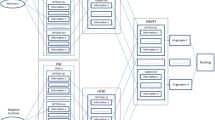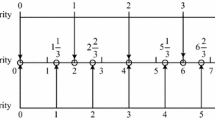Abstract
As a generalized fuzzy set, the dual hesitant bipolar fuzzy set (DHBFS) has received considerable attention and has recently become a widespread topic. The DHBFSs can reflect the disagreement and hesitancy of decision-makers flexibly and conveniently. However, we find that in DHBFS, all elements are endowed with the same importance, which indicates that multiple occurrence and appearance of some elements is neglected, which is evidently impractical. To circumvent this issue, this article aims to originate a new fuzzy tool, namely the probabilistic hesitant bipolar fuzzy set (PHBFS), which takes into account not only different grades of membership and negative membership but also their probabilistic data. Further, we outline some basic concepts, including score function, accuracy degree, normalization, comparison rule, and basic operations for PHBFS. Besides, we formulate some aggregation operators for aggregating probabilistic hesitant bipolar fuzzy information, including probabilistic hesitant bipolar fuzzy Hamacher prioritized average operator, probabilistic hesitant bipolar fuzzy Hamacher prioritized geometric operator and their weighted forms. Several special cases of these propound operators are also outlined. Based on these foundations, we develop a multi-criteria group decision-making method to cope with probabilistic hesitant bipolar fuzzy information-based problems. The proposed methodology is more reasonable for getting a better selection result and can overcome the disadvantage of information loss. At last, the proposed method is employed in the decision-making case related to recruiting foreign faculty members, and its practicality and effectiveness are verified.




Similar content being viewed by others
References
Akram M (2011) Bipolar fuzzy graphs. Inf Sci 181(24):5548–5564
Ali J (2022) Hesitant fuzzy partitioned Maclaurin symmetric mean aggregation operators in multi-criteria decision-making. Phys Scr 97(7):075208
Ali J, Naeem M (2022) Complex q-rung orthopair fuzzy aczel-alsina aggregation operators and its application to multiple criteria decision-making with unknown weight information. IEEE Access 10:85315–85342
Ali J, Naeem M (2023) r, s, t-spherical fuzzy VIKOR method and its application in multiple criteria group decision making. IEEE Access 11:46454–46475
Ali J, Bashir Z, Rashid T (2021) On distance measure and TOPSIS model for probabilistic interval-valued hesitant fuzzy sets: application to healthcare facilities in public hospitals. Grey Syst Theory Appl. https://doi.org/10.1108/GS-07-2020-0092
Ali J, Bashir Z, Rashid T (2021) WASPAS-based decision making methodology with unknown weight information under uncertain evaluations. Expert Syst Appl 168:114143
Ali J, Bashir Z, Rashid T (2021) Weighted interval-valued dual-hesitant fuzzy sets and its application in teaching quality assessment. Soft Comput 25(5):3503–3530
Ali J, Naeem M, Mahmood W (2023) Generalized q-rung picture linguistic aggregation operators and their application in decision making. J Intell Fuzzy Syst 44(3):4419–4443
Bashir Z, Ali J, Rashid T (2021) Consensus-based robust decision making methods under a novel study of probabilistic uncertain linguistic information and their application in forex investment. Artif Intell Rev 54(3):2091–2132
Böhme G (2013) Fuzzy-Logik: Einführung in die algebraischen und logischen Grundlagen. Springer, Berlin
Farid HMA, Riaz M, Khan MJ, Kumam P, Sitthithakerngkiet K (2022) Sustainable thermal power equipment supplier selection by Einstein prioritized linear diophantine fuzzy aggregation operators. AIMS Math 7:11201–11242
Gao H, Wei G, Huang Y (2017) Dual hesitant bipolar fuzzy Hamacher prioritized aggregation operators in multiple attribute decision making. Ieee Access 6:11508–11522
Gao H, Lu M, Wei Y (2019) Dual hesitant bipolar fuzzy Hamacher aggregation operators and their applications to multiple attribute decision making. J Intell Fuzzy Syst 37(4):5755–5766
Gul Z (2015) Some bipolar fuzzy aggregations operators and their applications in multicriteria group decision making. PhD thesis, Hazara University Mansehra, Pakistan
Hamacher H (1975) Über logische Verknüpfungen unscharfer Aussagen und deren zugehörige Bewertungsfunktionen
Han Y, Shi P, Chen S (2015) Bipolar-valued rough fuzzy set and its applications to the decision information system. IEEE Trans Fuzzy Syst 23(6):2358–2370
Herrera-Viedma E, Herrera F, Chiclana F (2002) A consensus model for multiperson decision making with different preference structures. IEEE Trans Syst Man Cybern Part A Syst Hum 32(3):394–402
Jana C (2021) Multiple attribute group decision-making method based on extended bipolar fuzzy MABAC approach. Comput Appl Math 40(6):227
Jana C, Pal M, Wang J-Q (2020) Bipolar fuzzy Dombi prioritized aggregation operators in multiple attribute decision making. Soft Comput 24(5):3631–3646
Joshi DK, Awasthi N, Chaube S (2022) Probabilistic hesitant fuzzy set based MCDM method with applications in portfolio selection process. Mater Today Proc 57:2270–2275
Klement EP, Mesiar R, Pap E (2013) Triangular norms, vol 8. Springer, Berlin
Krishankumaar R, Mishra AR, Gou X, Ravichandran K (2022) New ranking model with evidence theory under probabilistic hesitant fuzzy context and unknown weights. Neural Comput Appl 34:3923–3937
Li J, Wang Z-X (2019) Multi-attribute decision making based on prioritized operators under probabilistic hesitant fuzzy environments. Soft Comput 23(11):3853–3868
Liu X, Wang Z, Zhang S, Garg H (2021) An approach to probabilistic hesitant fuzzy risky multiattribute decision making with unknown probability information. Int J Intell Syst 36(10):5714–5740
Lotfi Z (1965) Fuzzy sets. Inf Control 8:338–353
Mahmood T, Ali Z (2022) Prioritized Muirhead mean aggregation operators under the complex single-valued neutrosophic settings and their application in multi-attribute decision-making. J Comput Cogn Eng 1(2):56–73
Mahnaz S, Ali J, Malik MA, Bashir Z (2021) T-spherical fuzzy frank aggregation operators and their application to decision making with unknown weight information. IEEE Access 10:7408–7438
Mujeeburahman T, Hussain RJ (2023) 2-secure domination in bipolar hesitancy fuzzy graph. Asian Res J Math 19(7):56–64
Palanikumar M, Arulmozhi K, Jana C (2022) Multiple attribute decision-making approach for Pythagorean neutrosophic normal interval-valued fuzzy aggregation operators. Comput Appl Math 41(3):90
Paul TK, Pal M, Jana C (2022) Portfolio selection as a multicriteria group decision making in pythagorean fuzzy environment with GRA and FAHP framework. Int J Intell Syst 37(1):478–515
Qahtan S, Alsattar HA, Zaidan A, Deveci M, Pamucar D, Delen D, Pedrycz W (2023) Evaluation of agriculture-food 4.0 supply chain approaches using fermatean probabilistic hesitant-fuzzy sets based decision making model. Appl Soft Comput 138:110170
Riaz M, Athar Farid HM, Kalsoom H, Pamučar D, Chu Y-M (2020) A robust q-rung orthopair fuzzy einstein prioritized aggregation operators with application towards MCGDM. Symmetry 12(6):1058
Sałabun W, Urbaniak K (2020) A new coefficient of rankings similarity in decision-making problems. In: International conference on computational science. Springer, Berlin, pp 632–645
Sarwar M, Akram M, Zafar F (2018) Decision making approach based on competition graphs and extended TOPSIS method under bipolar fuzzy environment. Math Comput Appl 23(4):68
Tian C, Peng JJ, Zhang ZQ, Wang JQ, Goh M (2022) An extended picture fuzzy MULTIMOORA method based on Schweizer-Sklar aggregation operators. Soft Comput 26:3435–3454
Torra V (2010) Hesitant fuzzy sets. Int J Intell Syst 25(6):529–539
Wei G, Lu M (2017) Dual hesitant pythagorean fuzzy Hamacher aggregation operators in multiple attribute decision making. Arch Control Sci 27(3)
Wei G, Alsaadi FE, Hayat T, Alsaedi A (2018) Bipolar fuzzy Hamacher aggregation operators in multiple attribute decision making. Int J Fuzzy Syst 20(1):1–12
Xu Z (2008) Group decision making based on multiple types of linguistic preference relations. Inf Sci 178(2):452–467
Xu Z, Cai X (2010) Recent advances in intuitionistic fuzzy information aggregation. Fuzzy Optim Decis Making 9(4):359–381
Xu X-R, Wei G-W (2017) Dual hesitant bipolar fuzzy aggregation operators in multiple attribute decision making. Int J Knowl Based Intell Eng Syst 21(3):155–164
Xu Z, Xia M (2011) Distance and similarity measures for hesitant fuzzy sets. Inf Sci 181(11):2128–2138
Xu Z, Zhou W (2017) Consensus building with a group of decision makers under the hesitant probabilistic fuzzy environment. Fuzzy Optim Decis Making 16(4):481–503
Yager RR (2008) Prioritized aggregation operators. Int J Approx Reason 48(1):263–274
Yang H-L, Li S-G, Yang W-H, Lu Y (2013) Notes on bipolar fuzzy graphs. Inf Sci 242:113–121
Yu D, Wu Y, Lu T (2012) Interval-valued intuitionistic fuzzy prioritized operators and their application in group decision making. Knowl-Based Syst 30:57–66
Zararsız Z, Riaz M (2022) Bipolar fuzzy metric spaces with application. Comput Appl Math 41(1):49
Zedam L, Pehlivan NY, Ali Z, Mahmood T (2022) Novel Hamacher aggregation operators based on complex t-spherical fuzzy numbers for cleaner production evaluation in gold mines. Int J Fuzzy Syst 24:2333–2353
Zhang W-R (1994) Bipolar fuzzy sets and relations: a computational framework for cognitive modeling and multiagent decision analysis, in NAFIPS/IFIS/NASA’94. In: Proceedings of the first international joint conference of the north American fuzzy information processing society biannual conference. The Industrial Fuzzy Control and Intelligent, IEEE, pp. 305–309
Zhang W-R (1998) Bipolar fuzzy sets. In: 1998 IEEE international conference on fuzzy systems proceedings, IEEE world congress on computational intelligence (Cat. No. 98CH36228), vol 1. IEEE, pp 835–840
Zhang W-R (2016) G-CPT symmetry of quantum emergence and submergence-an information conservational multiagent cellular automata unification of CPT symmetry and CP violation for equilibrium-based many-world causal analysis of quantum coherence and decoherence. J Quant Inf Sci 6(2):62
Zhang W-R, Peace KE (2014) Causality is logically definable-toward an equilibrium-based computing paradigm of quantum agents and quantum intelligence (QAQI) (survey and research). J Quant Inf Sci 4:227–268
Zhang W-R, Zhang L (2004) Yinyang bipolar logic and bipolar fuzzy logic. Inf Sci 165(3–4):265–287
Zhang S, Xu Z, He Y (2017) Operations and integrations of probabilistic hesitant fuzzy information in decision making. Inf Fus 38:1–11
Author information
Authors and Affiliations
Corresponding author
Additional information
Publisher's Note
Springer Nature remains neutral with regard to jurisdictional claims in published maps and institutional affiliations.
Rights and permissions
Springer Nature or its licensor (e.g. a society or other partner) holds exclusive rights to this article under a publishing agreement with the author(s) or other rightsholder(s); author self-archiving of the accepted manuscript version of this article is solely governed by the terms of such publishing agreement and applicable law.
About this article
Cite this article
Ali, J. Probabilistic hesitant bipolar fuzzy Hamacher prioritized aggregation operators and their application in multi-criteria group decision-making. Comp. Appl. Math. 42, 260 (2023). https://doi.org/10.1007/s40314-023-02387-7
Received:
Revised:
Accepted:
Published:
DOI: https://doi.org/10.1007/s40314-023-02387-7
Keywords
- Dual hesitant bipolar fuzzy sets
- Probabilistic hesitant bipolar fuzzy sets
- Hamacher operations
- Prioritized operators
- MCGDM




